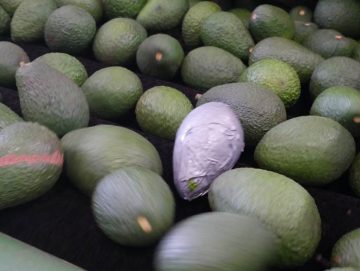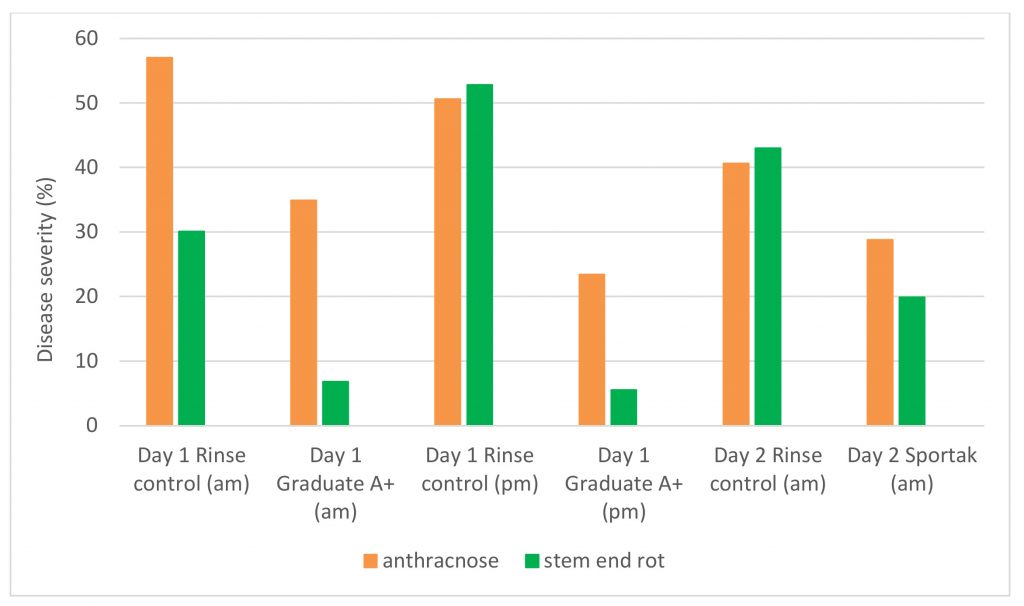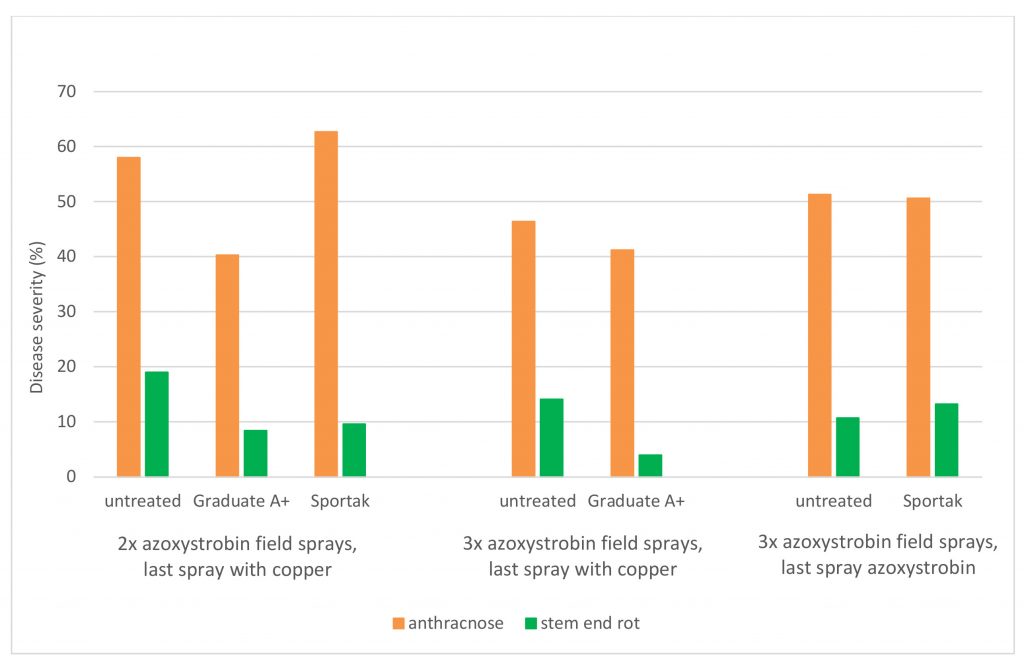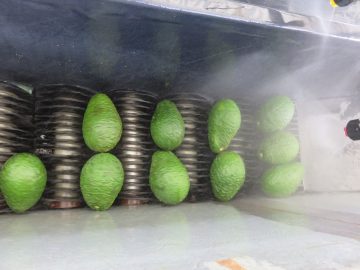Key messages
- Premium fruit quality is the responsibility of everyone along the supply chain, and begins with good orchard management to limit infections from fungi causing anthracnose and stem-end rot during fruit development.
- Post-harvest treatments should not be used as a “Band-Aid” to cure infected fruit coming into the supply chain.
- Graduate A+ is an effective post-harvest treatment, particularly for stem-end rot
- Further trials are required to test electrolysed oxidising (EO) water under commercial conditions, but initial work is promising.
- Combinations of EO water and Graduate A+, or other products as they are available, may enhance robustness of fruit through extended storage and transport chains, resulting in premium quality fruit at point-of-sale and a pleasurable experience for the consumer
Introduction
There are several diseases and other physiological disorders of avocado fruit impacting the quality of product and eating experience for the consumer. Trees and fruit are pushed to their limits in terms of yields, productivity, biotic stress (diseases and insect pressure) and abiotic stress (floods, drought, low soil fertility etc). On top of this, as production volumes increase and export markets expand, fruit are stored and transported for lengthy periods after harvest and frequently subjected to undesirable spikes in temperature. No wonder fruit doesn’t always arrive in the best condition! It is the responsibility of all stakeholders in the chain to supply avocado fruit of high quality with minimal post-harvest wastage.
In Australia, the primary diseases (rots) affecting avocado fruit after harvest are anthracnose and stem-end rot. Anthracnose (Figure 1) is primarily caused by fungal Colletotrichum species, and while fruit may be infected at any time during their development, the fungus remains dormant for many months after penetrating the fruit cuticle without causing obvious symptoms. After harvest, during the ripening process, the fungus resumes growth causing disease symptoms. Several fungal species are associated with stem-end rot (Figure 2), including Colletotrichum spp., Diaporthe (Phomopsis) spp., Pestalotiopsis and species in the Botryosphaeriaceae family (Lasiodiplodia spp., Fusicoccum spp., and Neofusicoccum spp.). These fungi are frequently present as endophytes internally infecting living plant tissues without causing any visible disease for at least part of their life cycle. They may colonize the fruit peduncle and be present in the stem end of harvested fruit. During ripening the fungi recommence growth and become pathogens, causing disease emanating from the stem end, frequently tracking along the vascular strands within the pulp (Figure 2). Stem-end rot is frequently worse in fruit from stressed trees, such as those in decline from Phytophthora root rot.


Anthracnose, caused by Colletotrichum spp. fungi. Note the hemispherical lesions arising from initial infection of the peel, and rotting into the pulp.
Growers should not rely solely on post-harvest fungicide treatments to manage fruit diseases such as anthracnose and stem-end rot. Management of these diseases must commence on-farm with a combination of tools for high-health orchards. These include orchard hygiene and canopy management to reduce fungal spore load and infection events, strategic applications of registered fungicides, optimal irrigation and nutrition for healthy trees and robust fruit, and careful harvest and post-harvest practices (find out more in the Best Practice Resource).
Research undertaken in AV16007 evaluated post-harvest treatments including Graduate A+, a fungicide comprised of two active ingredients, azoxystrobin and fludioxonil, as well as electrolysed oxidising (EO) water, a chlorine-based sanitizer, for their effect on anthracnose and stem-end rot compared with the industry standard prochloraz, and some results are presented here.


Stem-end rot, arising from infection at the stem or “button” and progressing along the vascular strands.
Results
PART 1 Evaluation of Graduate A+ in commercial packing sheds in Queensland – demonstration trials
Three demonstration trials were undertaken in commercial packing sheds in Queensland, utilizing different post-harvest fungicide application methods. Samples of fruit were collected from the line after the initial rinse (as untreated control), and after fungicide spray with label rates of prochloraz or Graduate A+ (azoxystrobin + fludioxonil). Fruit were dried, packed into trays and transported to the laboratory facilities at Ecosciences Precinct, Brisbane. Fruit were maintained in a controlled environment room 23°C and 65% relative humidity to encourage expression of disease. Fruit were checked each day and removed from the ripening room when deemed “eating soft” and assessed for severity of symptoms caused by anthracnose and stem-end rot.
Trial 1 Non-recirculating spray, North Queensland
Graduate A+ (250mL/100L) was applied via a non-recirculating spray system for 30 seconds (Figure 3). Both anthracnose and stem-end rot were reduced by Graduate A+ treatment (Figure 4), with the severity of stem-end rot 8-fold lower than in rinsed control fruit.



Trial 2 Recirculating spray, Central Queensland
Graduate A+ (250mL/100L) was applied via a recirculating spray system for 30 seconds. One tank (about 650 L) of Graduate A+ was prepared in the morning of Day 1. From the first bin of the day to the last, 48 tonnes of fruit passed through the line and spray solution volume dropped to approximately 375L In the morning of Day 2, prochloraz (Sportak, 55mL/100L) was prepared and applied for the day. Fruit from the same orchard was treated with both Graduate A+ and prochloraz.
Fruit treated with Graduate A+ in the morning or afternoon of Day 1 had less severe anthracnose and stem-end rot compared with respective fruit that went through the rinse only (Figure 5). Stem-end rot was reduced up to 10-fold compared with control fruit. On the second day, anthracnose and stem-end rot were reduced by prochloraz treatment, although reduction in stem-end rot (about twofold) was less than that achieved by Graduate A+ the previous day.

Trial 3 Non-recirculating spray, Central Queensland
The trial with cv. Wurtz incorporated a combination of field sprays of Amistar (azoxystrobin) or copper prior to harvest. The post-harvest treatments were applied through a non-recirculating spray tunnel for 30 seconds. The results show two field sprays with azoxystrobin (one early season and one close to harvest) followed by Graduate A+ post-harvest provided similar levels of anthracnose control as that when three field sprays of azoxystrobin (one early season and two close to harvest) then Graduate A+ were applied (Figure 6). Stem-end rot was least severe when fruit were treated after harvest with Graduate A+.

PART 2: Effects of treatment with electrolyzed oxidizing water on postharvest diseases of avocado
Electrolyzed oxidizing (EO) water is generated by electrolysis of a dilute salt solution, and its microbiocidal effect is attributed to its high oxidation reduction potential and available chlorine (predominantly as hypochlorous acid). There are several benefits of EO water over other chlorine-based sanitisers, including its low corrosion potential, low toxicity and irritant levels (thus safe for operators), production on-site, and negligible residue and waste issue as the active chlorine decomposes back into dilute saline solution. Furthermore, it is an approved input in organic production systems. EO water-generating systems are now commonplace in many hospitals and facilities processing and packing fresh meat, fish, herbs, fruit and vegetables.
Five separate trials were conducted with fruit harvested at commercial maturity (24-34% dry matter) from orchards with known high anthracnose and stem-end rot disease pressure. In the first 4 trials fruit were dipped for 30 seconds in 20% v/v EO water, and stem-end rot (but not anthracnose), was significantly reduced compared with water control (results not shown). However, treatments in the final trial were applied as overhead recirculating sprays in an experimental-scale packing line to simulate commercial conditions (Figure 7). Anthracnose was reduced similarly by both EO water and Graduate A+ compared with water control treatment (Figure 8). The full article and results can be downloaded here https://www.mdpi.com/2077-0472/9/11/241.


Discussion
Graduate A+ was registered in Australia for post-harvest use in 2018, and has been adopted by many packing sheds. It has been shown to be particularly effective against stem-end rot disease. One of the limitations to adoption more widely has been the somewhat conflicting label statements. The azoxystrobin label currently states that the final field spray with azoxystrobin should be 7 days prior to harvest. Thus, azoxystrobin is typically the very last fungicide to be applied in field. However, the Graduate A+ label states that under the Crop Life Fungicide Resistance Management strategy, Graduate A+ must not be applied to avocado if Amistar (azoxystrobin, or similar Group 11 fungicide) was the final field spray. This has prompted Syngenta to apply for a label amendment to clarify that azoxystrobin does not have to be the final field spray. Further testing is required, however, our preliminary data suggests that two field sprays with azoxystrobin (with the second close to harvest) followed by Graduate A+ in the packingline, may be sufficient for very high-quality fruit with minimal postharvest disease breakdown.
The research also demonstrates the potential for electrolysed oxidising water to be incorporated into integrated management programs for avocado, and possibly other fresh produce. As an approved input for organic production, it may be a strategy worth investigating for stakeholders in the organic food industry. Further trials in commercial packing sheds are required to confirm these preliminary results. As well as reducing fungal rots in fruit, it is likely to reduce foodborne (human) bacterial pathogens such as Salmonella spp., Listeria monocytogenes and Escherichia coli, on fruit surfaces and in processed pulp products. EO water-generating systems are now commonplace in many hospitals and facilities processing and packing fresh meat, fish, herbs, fruit and vegetables. Conceivably, an initial wash with EO water followed by fungicide treatment could be easily integrated into fresh fruit packing facilities.
Acknowledgment
Improving avocado orchard productivity through disease management (AV16007) is funded by Hort Innovation, using the avocado research and development levy and contributions from the Australian Government. Hort Innovation is the grower-owned, not-for-profit research and development corporation for Australian horticulture. The project is jointly supported by the Department of Agriculture and Fisheries and The University of Queensland.
M. K. Hassan received an Endeavour Research Fellowship from the Department of Education and Training Australia via to allow his six-month placement to undertake the study with EO water. The authors also acknowledge useful interactions and support received from Professor Roger Stanley (University of Tasmania), Keith Mason (EnviroLyte Asia Pacific), Mark Parkinson (Lockyer Agronomics Pty Ltd), Anderson Horticulture Pty Ltd. We gratefully acknowledge the owners and staff of three packing sheds in Queensland for their cooperation in conducting the post-harvest trials.
Authors:
By Elizabeth Danna, Shaun Hood b, Akila Prabhakarana, Kamrul Hassana,c
a University of Queensland, St Lucia, QLD 4072, Australia
b Syngenta Australia Pty. Ltd., North Ryde, NSW 2113, Australia
c Bangladesh Agricultural University, Mymensingh 2202, Bangladesh
References: Hassan, M. K. and Dann, E. K. (2019) Effects of treatment with electrolyzed oxidizing water on postharvest diseases of avocado, Agriculture, 9 (11): 241 https://doi.org/10.3390/agriculture9110241 (published in the special issue Postharvest Physiology and Technology of Fruits and Vegetables)
Source: This article was first published in the Autumn 2020 Talking Avocados magazine. View online via Avocados Australia.
Contact: Associate Professor Elizabeth Dann, Principal Research Fellow, Centre for Horticultural Science, Queensland Alliance for Agriculture and Food Innovation, The University of Queensland, T: +61 7 344 32455 E: e.dann@uq.edu.au





